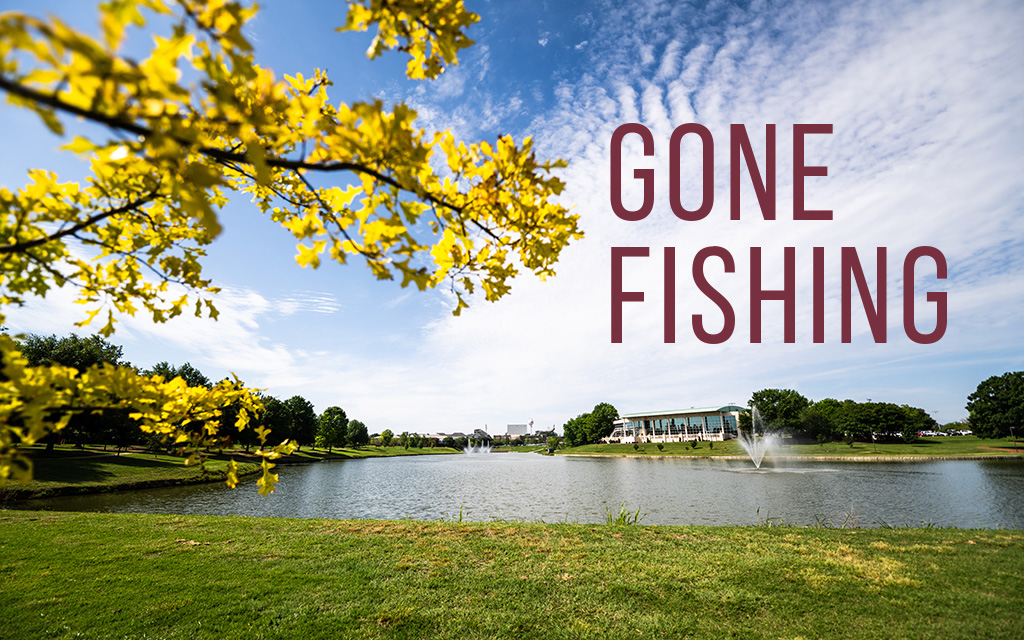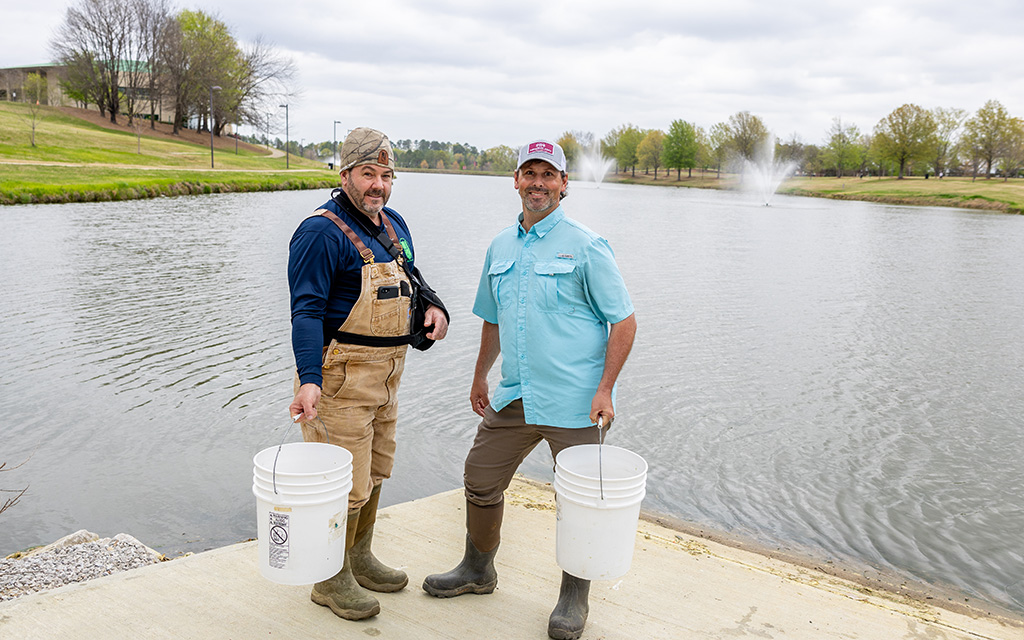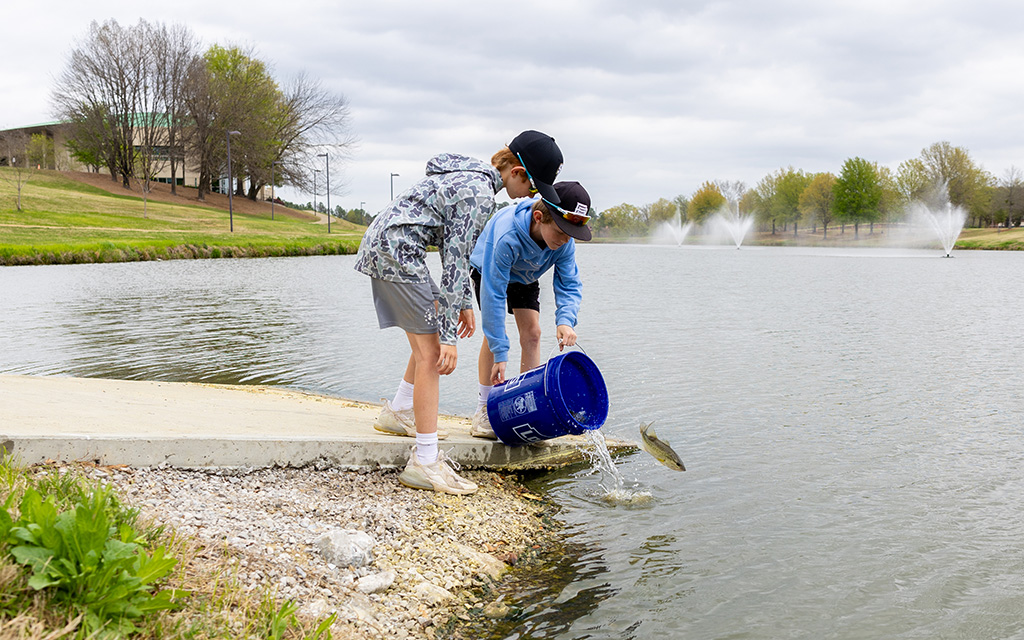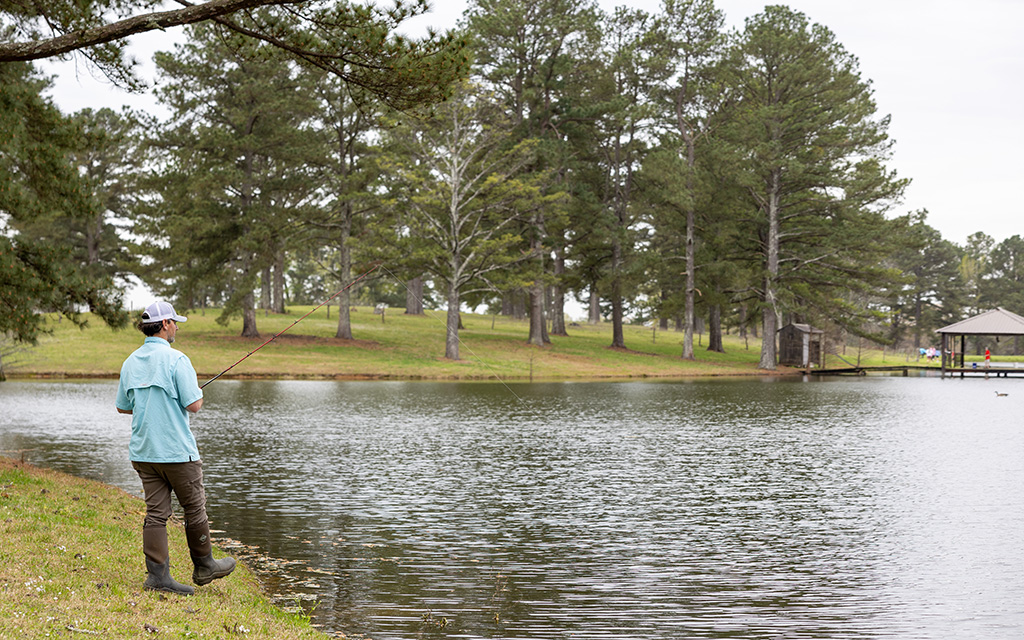
Rehabilitation opens Chadwick Lake to recreation once again
Since the 1990s, Chadwick Lake has served the Bulldog family as a resource for rest, recreation and recuperation. Now, a renewed restoration effort will allow it to thrive for generations of future Bulldogs.
“Bodies of water are incredibly valuable to communities, and the same is true for Chadwick Lake and MSU,” said Saunders Ramsey, executive director of MSU’s Campus Services. “The lake is one of those iconic outdoor spaces on campus with limitless potential.”
Located on the northeast side of campus where it anchors MSU’s athletic district, the 12-acre lake was constructed in the 1960s to serve a functional purpose. The 1990s ushered in recreational uses of the space with the completion of two major capital projects that transformed the landscape: construction of the Bryan Building, which houses Bulldog athletic administration, and the campus fitness center, the Joe Frank Sanderson Center.
With its proximity to the campus fitness and recreation center, Chadwick Lake quickly became a popular spot for scenic strolls, while its surrounding green spaces are perfect for picnics and games of disc golf on its nine-hole course along the lake’s perimeter.
Most recently, the 2013 addition of a 1-mile path around its shore helped the lake capitalize on its potential. Ramsey, a 2005 MSU civil engineering graduate, oversaw that project as a consultant with Neel-Schaffer.
“The track is one of the first projects I ever designed for Mississippi State,” Ramsey said. “It was a cornerstone of a health and wellness initiative on campus, and that really increased the lake’s visibility and boosted its popularity.”
Upon joining the MSU staff in 2020, Ramsey was eager to reconnect with campus and redefine the outdoor spaces that shape the campus experience. He found his first opportunity in Chadwick Lake, a scenic focal point for those entering campus from Highway 182 or attending Bulldog sporting events. Once a vibrant habitat for fish, turtles and waterfowl, it was in the midst of an algae overgrowth.
“There was a layer of green algae covering the lake which signaled an imbalance in its ecosystem,” Ramsey said.
Ramsey connected with Mark Peterman, a senior research associate and applied aquatic biologist at MSU’s College of Veterinary Medicine who has studied Chadwick Lake for almost 30 years. Peterman specializes in fish health and water quality, including phycology—the study of algae.
“Green water isn’t uncommon to man-made freshwater lakes, but the algal bloom at Chadwick was significant,” Peterman said.
The lake’s level was lowered to target and treat the overgrowth of algae and to identify the cause of it.



Top Right: Associate director of campus grounds Jim Bo Hearnsberger, right, and Mark Peterman, an applied aquatic biologist at MSU, coordinated a catch-and-release fishing day with members of the MSU Campus Services team and their families at a local, privately owned, overstocked pond. The catch was carefully transported and released into Chadwick Lake, helping both waterways move toward better ecological balance.
“We discovered high levels of nutrients in the water column and pond sediments were the underlying causes of the algal blooms,” Peterman said.
Peterman collaborated with Campus Services to implement safe and effective algal bloom-management strategies and a comprehensive and preventative treatment plan to care for the lake and maintain a beautiful and healthy aquatic ecosystem.
In addition to introducing environmentally friendly algaecides, restoration plans included constructing a berm using natural materials to absorb excess nutrients and prevent them from entering the lake. Floating fountains attached to submersed aerators were installed in the lake to improve water circulation and increase oxygen levels. The lake also was dredged to remove nutrient-dense sediment contributing to the excessive algae growth.
“The fountains look really nice, but they are also functional,” Peterman said. “When combined with the aerators, the water bubbles up from the bottom of the lake, and the fountains help keep it mixed to flush out nutrients, especially during periods of high rainfall. All of these efforts really worked together to calm the algae and balance the lake’s ecosystem.”
The restoration efforts were so effective that Peterman applied them to aid the $1.9 billion farm-raised catfish industry.
“The same species of algae showing up at Chadwick Lake was also negatively impacting the commercial catfish industry,” he said. “After doing some research, we decided to apply the mitigation measures we used at Chadwick Lake to commercial catfish ponds, and it worked. We have a new management tool for catfish producers that’s evolved from our work at Chadwick Lake.”
A Healthy Habitat for Fish
With Chadwick Lake stabilized, Peterman began studying the health of the fish in the lake and exploring reestablishing the lake as a fishery—something he did as a graduate student in the late 1990s when he worked as an aquaculture and fisheries technician.
“When the Sanderson Center had just opened, I helped develop some outdoor programming including a catch-and-release program at the lake,” recalled Peterman, a 1996 MSU fisheries management graduate.
Last spring, Peterman recruited other MSU faculty, staff and students to form a multi-departmental effort to improve the lake’s habitat for fish and ultimately develop a plan to restore its once-thriving ecosystem. Through hands-on learning and real-world research experience, the team collected data including the variety, weight and measurements on the fish population in the lake.
“It was a great opportunity, especially for students, to learn and apply their knowledge of sustainable ecosystem management to address contemporary issues impacting the lake,” Peterman said.
Using a sampling technique called electrofishing, the students discovered the lake’s prey-to-predator fish ratio was unbalanced.
“That means there was an abundance of smaller fish such as bream in the lake, but there was an inadequate number of largemouth bass,” Peterman said.
To achieve a healthy, well-balanced fish population, the students recommended adding more largemouth bass to the lake.
“We had two options: we could purchase some larger bass, or we could catch and add them ourselves,” Peterman said.
Jim Bo Hearnsberger, an outdoor enthusiast and MSU’s associate director of campus grounds, organized a catch-and-release fishing day at a private pond in Oktibbeha County.
“We needed to catch a lot of fish,” Hearnsberger said. “I picked a Saturday in the spring and invited our Campus Services team and their families to join us to help restock Chadwick Lake.”
As almost 100 largemouth bass were reeled in, Peterman collected them in a large tank in the back of his truck and transported them to Chadwick Lake to release into the water. Some of the fish released into the lake should spawn this year.
“The lake connects us, blending history, nature and community,” Ramsey said. “We recognize the value of Chadwick Lake, and we have a tremendous responsibility to take care of it, not only because of its value and importance to campus but also to our community—to our neighbors.”
By Nicole Thomas, Photos by Lana Bentley and Grace Cockrell
GET OUTSIDE
Though Chadwick Lake needs a little more time to reestablish its fish population before people resume fishing, the lake, as well as the rest of Mississippi State’s vast, picturesque campus, offers a variety of other outdoor activities and spaces to be enjoyed.
“The outdoor spaces at MSU are a key part of campus life that build a strong sense of community and connection to campus,” said Saunders Ramsey, executive director of MSU’s Campus Services.
- Green spaces: MSU’s iconic Drill Field and Junction are favorites of students, families and campus visitors alike. Open to everyone and at the heart of MSU’s campus, they’re not just pedestrian thoroughfares or gameday hangouts—they also serve as gathering places, venues for impromptu yard games and picnic sites. They are also perfect for relaxing between classes, studying under the sun or participating in student-led activities and events.
- Relaxing Retreats: Lounge chairs, picnic tables and hammock hangars strategically placed around campus invite students to take a break, read a book or visit with friends. These outdoor seating arrangements line the landscapes of the Cobb Institute of Archaeology, Colvard Student Union, Old Main Academic Center and Allen, Lee, Bowen and Hilbun halls.
- Scenic Vistas: For those seeking a quiet outdoor escape, Eckie’s Pond on the southeast side of MSU’s campus offers a serene, tranquil spot to relax, reflect and enjoy the natural beauty of campus. The university also maintains the Veteran’s Memorial Rose Garden off state Highway 182 on the north side of campus, while a bike lane on Hail State Boulevard guides riders between the pastures of South Farm.
- Recreation Opportunities: MSU’s campus offers two disc golf courses: nine holes around Chadwick Lake and 18 holes at the Wise Center, the home of MSU’s College of Veterinary Medicine. The Chadwick Lake area also boasts a walking track, outdoor gym and sand volleyball court. The University RecPlex offers six outdoor tennis courts—including two that double as pickleball courts—as well as softball and multipurpose fields. While some of these are open and free to use, others require a reservation and small rental fee. Visit www.urec.msstate.edu for more information about rules for use.
The university is continuing to create inviting and useful outdoor spaces and expand its offerings for the MSU family. Plans for future construction include an eight-court outdoor pickleball complex on the Sanderson Center’s grounds, among other amenities.
“We are investing in the continued development of outdoor recreation areas to enhance the campus experience and further MSU’s commitment to learning, recreation and overall well-being,” Ramsey said.








